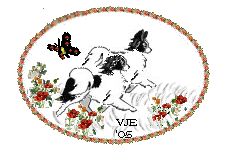

 
The Papillon & The Phalène
The Papillon, also known as the Epagneul Nain Continental is often called the "Butterfly Dog" because of its fringed ears
that resemble a butterfly's outspread wings, the Papillon (Pap-e-yon)/Phaléne('Fah-len'') is one of the
oldest purebred Toys. The original ENC is the Phaléne (with an accent mark over the first è) with the Papillon, which was the
later development of the breed, being the second variety. Although in
Europe the Epagneul Nain Continental still goes by it's original name
here, in the USA, and some other countries, the name of the one
variety (Papillon) ended up being used to represent both varieties, at times excluding the delightful Phaléne variety from the recognition it rightfully deserves.

FACT - The Papillon is only one variety of the Epagneul Nain Continental, the Phaléne being the other.
The dropped ear still survives, (and is making a come back), in the variety known as the Phaléne('Fah-len'), named
for a moth that droops it's wings, to distinguish it from the erect-eared variety
the Papillon or Butterfly dog. The varieties with their delightful ears, waving tail plume, and flowing coat,
are a sure standout in any crowd. The varieties possess what has been termed "sensible glamour"
because the owner does not have to become a slave to preserve its beauty.

It appears in paintings in Italy as far back as the 15th century. In
France the court ladies and royal children were frequently painted with a Toy Spaniel pet,
as the breed was then known. As the merchant class in the Low Countries (modern Belgium
and Holland) became wealthy, the little dwarf spaniel appeared in many family scenes.
Gradually painters all over Europe were portraying them. These Toy Spaniels had drooping
ears, but otherwise the prettiest of them were unmistakably the same breed we have today.

The Papillon and Phaléne have no doggy odor and it's silky coat is not prone to
matting. However, Papillons and Phalénes love to be clean and bathing is easy; they wash like an orlon
sweater! They have no dense undercoat to shed out twice a year as with most long-haired
breeds and the resilient coat texture sheds dirt and dry grass with the touch of a brush.
The pet Papillon and Phaléne require no trimming of the coat, although the bottoms and sides of the
feet can be trimmed for a more tidy appearance (this is usually done for the show ring).

The possibilities for color and markings are very nearly unlimited so
you will find no two Papillons or Phalénes exactly alike. For the show ring color should cover both ears and extending over both eyes. Patches of
color on the body may be of any size or shape, and of any color including black, tricolor,
red, orange, tan, and sable. A symmetrical white blaze and noseband are preferred on the
face but not essential for competition. Their height at the top of the shoulder blade
averages 8" to 12", and over 12 inches is a disqualification.
This is the size range allowed in dog show competition, but smaller and larger individuals do occur
infrequently. The delicate tinies can serve as exquisite companions for senior citizens,
while the oversized ones with larger, stronger bones make delightful additions to active
families with well-behaved children.

The Papillon and Phaléne are generally outgoing and friendly, although how
extroverted it will be with strangers varies with how it was raised. Both males and
females make equally suitable pets, and of course, should always be neutered or spayed if
not destined for the dog show ring.
Papillons and Phalénes are generally very social with other animals, and make wonderful companions to
other dogs and cats too. A word of warning though they ignore all size differential and
will entice much larger dogs to play, often with disastrous results. Their preference is
to be with people, not only to be cuddled in a lap, but to accompany walks, car trips, TV
watching, etc. Papillons and Phalénes are active, lively dogs, although generally not nervous or yappy.
They might alert you when someone is at the door but should quiet down immediately when
that person has been admitted as a friend.

Most Papillons and Phalénes retain their puppy playfulness to some degree throughout
their lives. They travel well (carsickness is rare), and enjoy the attention they draw
wherever they go. A Papillon or Phaléne can change homes at any age and if suitably placed, will
adjust happily. This is a relatively healthy breed. Although it cannot claim absolutely no
genetic problems (no breed and no species of animal is entirely free of harmful genes) but
in comparison with many breeds, the Papillon and Phaléne seem to have no serious problems widespread
throughout the population. They are seldom finicky eaters but are not prone to obesity.
Contrary to popular belief, they should not grow fat or change their personality after
being spayed or neutered. The Papillon or Phaléne is not considered to be a rare breed, although it
is far from common.

For 1988 it ranked 67th (among 129 breeds) with 1,209 new registrations
with the American Kennel Club. With growing popularity, regrettably, increased numbers are
being produced in "puppy mills" for distribution to pet shops. These puppies are
raised in deplorable conditions, as cheaply as possible, and often from lines containing
serious inheritable defects and questionable pedigree. Luckily, it is still mostly bred by
knowledgeable fanciers devoted to protecting its interests and producing stock that is
sound of mind and body. The Papillon's popularity also has grown at the dog shows because
they are easy for novice exhibitors to groom and handle. They also are known to "show
themselves" and will catch the judge's eyes by dancing happily on the lead with ears
held erect at attention and tail plume waving.

Their "trainability" ranks extraordinarily high, enhanced by a
strong desire to please; thus, they are rapidly becoming sought after as obedience
competition dogs. In comparison to the more common large breeds found in the obedience
trials, the Papillon's and Phaléne's small size, lively action, and intense attention to their handler
always draw a crowd of spectators to ringside. It is one of five top breeds in obedience competition when all its scores and titles are factored in with its registration figures.
It has been discovered that the Papillon and Phaléne has exceptional abilities in tracking (following
a human scent) and agility (maneuvering a canine obstacle course). The breed also is ideal
for service as Hearing Ear Dogs for the deaf and hearing impaired and therapy dogs
(visiting hospitals and nursing homes). It is often said that the Papillon is a big dog in
a little dog's body. They can do virtually all that a larger dog can do, but with less
effort, upkeep, and space requirements.

|
|
|
|
 


|
|
|
|